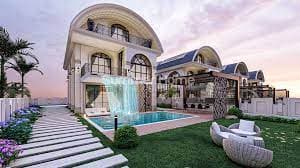The union of architecture and interior design is nothing short of a mesmerizing ballet in the complex realm of design. Form and function work together harmoniously, aesthetics and utility meld, and spaces come to life with meaning and beauty. Together, interior designers and architects produce settings that convey tales, arouse feelings, and leave a lasting impression. This essay delves into the art of creating inspiring settings by examining the seamless fusion of architecture and interior design.
The Architecture’s Canvas
Any structure’s shape, scale, and overall personality are determined by its architecture, which serves as its framework. It serves as the blueprint for the entire design process. Architects create the vast shapes of buildings by visualizing and sketching them.
Their works are more than just physical objects; they are also dynamic, living environments that engage with their surrounds.
When conceiving their designs, architects take into account factors including light, space, materials, and the surrounding environment. Modern buildings frequently blend the interior and exterior, allowing people to live in harmony with nature. Modern architectural wonders are characterized by the interaction of natural light, the movement of rooms, and the creative use of materials.
The Interior Design Color Scheme
Interior designers enter these rooms after the structural foundation has been established to create surroundings that are both useful and aesthetically beautiful. They concentrate on the interior components that define a home or workplace within a structure. Including furniture, lighting, color schemes, textures, and accessories, interior design is a multifaceted craft.
It involves constructing a space that speaks to the personalities and requirements of the people who will be using it.
A great eye for detail is a quality of interior designers. They comprehend how the positioning of furniture may affect the energy flow in a space, how color selection can affect mood, and how various textures can offer depth and warmth. Additionally, they frequently collaborate with architects to make sure that the interior spaces flow naturally with the architectural design.
Integration as a Practice
When these two disciplines combine, something magical happens. In order to improve the overall user experience, architects and interior designers work closely together. Large, floor-to-ceiling windows may be used in an architectural design to allow natural light to pour into the interior spaces of a structure.
As a result, an interior designer can opt for light-colored furniture and reflective surfaces to intensify the light and produce a spacious, airy atmosphere.
Additionally, both interior designers and architects are focusing on integrating sustainable practices. Eco-friendly building materials, energy-saving lighting, and cutting-edge ventilation techniques are becoming essential components of design. This thoughtful approach not only improves the environment but also the quality of life for the locals.
Conclusion
The interaction between interior design and architecture, two fields that are constantly changing, continues to influence how we perceive our environment. Together, architects and interior designers create places that are both aesthetically pleasing and functionally effective.
They design spaces that encourage innovation, enhance wellbeing, and encapsulate the character of the inhabitants.
The interaction between architecture and interior design will definitely result in breakthroughs that reshape our ideas of living and working places as we advance towards a future where the limits of design are further stretched. It is evidence of the potency of creative collaboration, where the fusion of vision and skill results in settings that astound, comfort, and inspire.
More on INJ Architects:


Comments are closed.